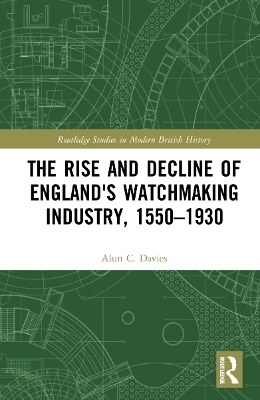
The Rise and Decline of England's Watchmaking Industry, 1550–1930
Routledge (Verlag)
978-1-032-13135-1 (ISBN)
This survey of the rise and decline of English watchmaking fills a gap in the historiography of British industry. Clerkenwell in London was supplied with 'rough movements' from Prescot, 200 miles away in Lancashire. Smaller watchmaking hubs later emerged in Coventry, Liverpool, and Birmingham. The English industry led European watchmaking in the late eighteenth century in output, and its lucrative export markets extended to the Ottoman Empire and China. It also made marine chronometers, the most complex of hand-crafted pre-industrial mechanisms, crucially important to the later hegemony of Britain’s navy and merchant marine. Although Britain was the 'workshop of the world', its watchmaking industry declined. Why? First, because cheap Swiss watches were smuggled into British markets. Later, in the era of Free Trade, they were joined by machine-made watches from factories in America, enabled by the successful application to watch production of the 'American system' in Waltham, Massachusetts after 1858. The Swiss watch industry adapted itself appropriately, expanded, and reasserted its lead in the world’s markets. English watchmaking did not: its trajectory foreshadowed and was later followed by other once-prominent British industries. Clerkenwell retained its pre-industrial production methods. Other modernization attempts in Britain had limited success or failed.
Dr Alun C. Davies, was educated at the universities of Aberystwyth and Princeton and retired in 1999 after thirty-three years at The Queen’s University of Belfast as Reader (and sometime Head of Department) in the Department of Economic and Social History.
Part 1: Rise 1. Origins: From Craft to Industry 2. Supply: Clerkenwell and Prescot: A Geographical Division of Labour 3; Supply: Two Other Hubs: Liverpool and Coventry 4. Towards English Horology’s Golden Age: Technology, Organisation, Rewards 5. Demand: Domestic, Government, and Foreign Part 2: Challenge 6. Clouds on the Horizon: Switzerland’s Challenge 7. War and Peace, 1793–1817: Crisis, Recovery, and Crisis Again 8. The 1817 Inquiry: Tariffs and Smuggling, 1818–1842 9. The Ingold Episode and After, 1842–1860 10. Meeting the Challenge: Chronometers in War and Peace, 1793–1860 Part 3: Decline 11. Revolution in America: Evolution in Switzerland 12. Consequences for Britain 13. The British Horological Institute: Ignoring the Elephant 14. Twilight in Clerkenwell: Ignoring the Market 15. Attempting the "American System": Birmingham, Coventry and Liverpool 16. English Chronometers Defy Decline 17. The Great War and After. Postscript: The Third Horological Era
| Erscheinungsdatum | 12.04.2022 |
|---|---|
| Reihe/Serie | Routledge Studies in Modern British History |
| Zusatzinfo | 11 Tables, black and white; 1 Line drawings, black and white; 20 Halftones, black and white; 21 Illustrations, black and white |
| Verlagsort | London |
| Sprache | englisch |
| Maße | 152 x 229 mm |
| Gewicht | 453 g |
| Themenwelt | Geschichte ► Allgemeine Geschichte ► Neuzeit (bis 1918) |
| Geisteswissenschaften ► Geschichte ► Regional- / Ländergeschichte | |
| Geschichte ► Teilgebiete der Geschichte ► Kulturgeschichte | |
| Geschichte ► Teilgebiete der Geschichte ► Wirtschaftsgeschichte | |
| Naturwissenschaften | |
| ISBN-10 | 1-032-13135-7 / 1032131357 |
| ISBN-13 | 978-1-032-13135-1 / 9781032131351 |
| Zustand | Neuware |
| Haben Sie eine Frage zum Produkt? |
aus dem Bereich


